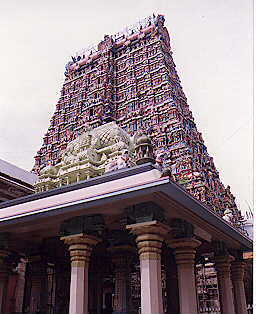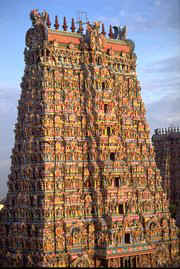Meenakshi Temple
|
The world famous Meenakshi temple is located in Madurai. This temple is dedicated to the Lord Shiva and Meenakshi. The Meenakshi temple complex is one of the largest and one of the most ancient city temple. The city of Madurai, was originally built around the Meenakshi temple. The rectangular streets named after the Tamil months surround the temple, symbolizing the structure of the cosmos. The architecture of the Meenakshi temple is splendour and outdoes all the temples. The Temple Complex in itself is breathtaking. The fort-like walls are pierced with lofty gopurams or towers, over an area of 640,000 square feet. The gopurams are adorned with figures of Hindu Gods, animals and mythological creatures. Upon entering
temple, one gets to view the spectacular "Potraamaraikkulam", meaning the Golden Lotus Pond, surrounded
by corridors depicting mural from the "Thiruvilaiyaadal Puraanam". The "Ayirangaal Mandapam" (Thousand Pillared Hall) is another exhibit of impressive craftsmanship whose pillars feature sculptural work beyond comparison.
Origin
of Meenakshi Temple
The Origin Of The Meenakshi Temple
and the Sri
Meenakshi Sundareswara temple and Madurai city originated together.
|
 |
|
|
According
to legends, once upon a time Lord Indra committed sin when he killed a demon, who was then performing penance.He could find no relief from remorse in his own kingdom so he came down to earth. While passing through a forest of Kadamba trees in Pandya land, he felt relieved of his burden. The people told him that there is a shivalinga under a Kadamba tree and beside a lake and by woshipping it you could be relieved of your burden. He worshipped that Linga and built a small temple around it. It is believed that it is this
Linga, which is still worshipped in the Madurai temple. The shrine is called the
"Indra Vimana". Once Dhananjaya, a merchant of Manavur, where the Pandyas had arrived after the second deluge in Kumari
Kandam, having been overtaken by nightfall in Kadamba forest, spent the night in the Indra
Vimana. When next morning he woke up, he was
surprised to see signs of worship. |
The Golden Lily Tank
From the banks of the lovely and historic Golden Lily tank the most popular photographic views of the temple are taken, that shows the gigantic south outer Gopura. The northern corridor leads directly to the shrine of the goddess. On its pillars are the images of some of the Sangam poets, of Kulasekhara Pandya, the first builder of the temple, and of Dhananjaya, who figures in the traditional story of its origin. The corridors around the tank are rightly called the "Chitra Mandapa", as the walls carry paintings of the divine sports of the Lord, as narrated in the "Tiruvilayadal Puranam". The paintings are renewed from time to time. Earlier some paintings were affixed on the wooden panels over an older series. These paintings were then removed to the Temple Museum in the thousand-pillared Mandapa, leaving some dilapidated murals to view. It is impossible to ascertain the date of these. It was in the sixteenth century that the corridors and the steps leading down to the tank were constructed. The northern corridor and steps were constructed in 1562, those on the east in 1573, and those on the south five years later. |
The Unjal and Kilikatti Mandapas
These two mandapas stand on the farther way to the shrine of the Goddess. On their ceilings are more paintings. A celebrated mural, opposite to the entrance of the shrine, depicts the marriage of Goddess
Meenakshi. The Kilikatti Mandapa derives its name from the fact that there are parrots in a cage here. On its walls are carvings of the divine sports. This mandapa is the most ornamental mandapa of temple, built in 1623.
|
|

|
Parts of the Temple Complex
The temple of Goddess Meenakshi consists of a square sanctum, an Ardhamandapa and a
Mukhamandapa. In the niches on the walls of the shrine are images of Iccasakthi in the south, Kriyasakthi in the west, and Jnanasakthi in the north. There are shrines of Vinayaka and Subramanya in the outer
Prakara. They probably belong to the fifteenth century. There are a number of historic shrines in the
Prakaras. Opposite to an entrance into the first from the Mahamandapa there is one of Lord
Sabhapathi. This is the famous Velliambalam where one of the Lord's divine sports took place when, at the request of the sages, Patanjali and
Vyagrapadha, he danced as Lord Nataraja. The enormous temple complex is dedicated to Shiva, known here as Sundareshvara and his consort Parvati or
Meenakshi. The original temple was built by Kulasekara
Pandya, but the entire credit for making the temple as splendid as it is today goes to the
Nayaks. The Nayaks ruled Madurai from 16th to 18th century and left a majestic imprint of their rule in the Meenakshi - Sundareswarar Temple. The temple complex is within a high-walled enclosure, at the core of which are the two sanctums for meenakshi and
Sundareshwara, surrounded by a number of smaller shrines and grand pillared halls. Especially impressive are the 12
gopuras. |
Ashta
Sakthi Mandapa
It is a tradition in this temple that the devotees must
first worship to the Goddess Meenakshi. Therefore, while
there are four other entrances into the temple, under huge
Gopuras in the four cardinal directions, but it is
customary to not to enter through any of them but through
a Mandapa, with no tower above it. This entrance leads
directly to the shrine of the Goddess.
Ashta Sakthi Mandapa is an impressive structure, with a
hemispherical ceiling. It is 14m long and 5.5m wide. There
are bas-reliefs all over the place. Over the entrance one
of them depicts the marriage of Goddess Meenakshi with
Lord Somasundara. The Mandapa derives its name, the "Ashta
Sakthi", from the fact it contains sculptures of the
eight Sakthis (also spelt as Shakti). Those of the four
principal Nyanmars were added during renovation of the
temple in 1960-63. |
Mudali Pillai Mandapa
The Mudali Pillai Mandapa follows the Chitra Gopura. This mandapa was added in 1613, and is 183m long and 7.6m wide. On its wall are many puranic scenes. In this mandapa there was no light, and windows were also added in the last renovation. |
The Thousand Pillar Mandapa
The Thousand Pillar Mandapa is the 'wonder of the palace'. But actually there are 985 beautifully decorated pillars. Each pillar is sculptured and is a monument of the Dravidan sculpture. There is a temple art museum in this 1000 pillars hall where you can see icons, photographs, drawings, etc., exhibiting the 1200 years old history. There are so many other smaller and bigger mandapams in the temple. Just outside this
mandapam, towards the west, are the Musical Pillars. Each pillar when stuck, produces a different musical note. |
Vasantha Mandapam
This mandapam was built by Thirumalai Nayakkar. Vasanthosavam, the Spring festival is celebrated in this mandapam in Vaikasi (April/May). Its pillars contain elaborate sculptures of Shiva, Meenakshi, scenes from their wedding as well as the figures of ten of the Nayak Kings and their consorts. This is also called Pudhu
Mandapam. |
|
|
|
|
|